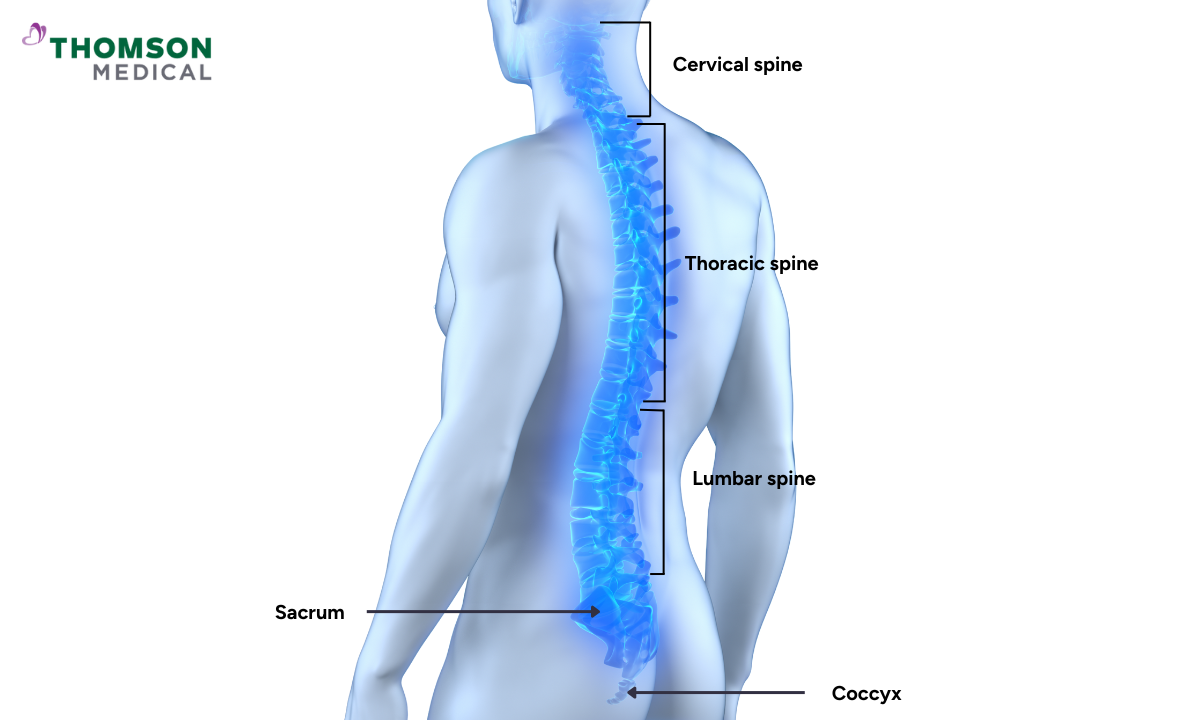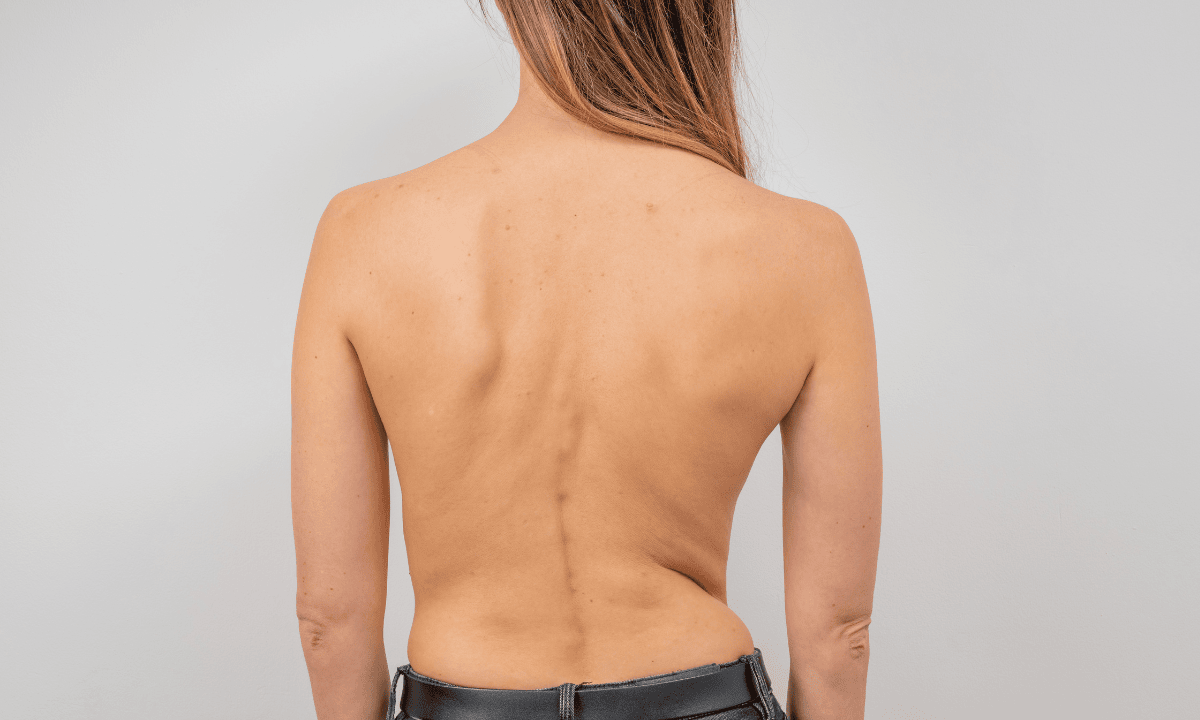What is scoliosis?
Scoliosis is a condition where the spine is abnormally curved sideways, forming the letter C or S when viewed from the back. This spinal curvature is commonly found in children between the ages of 10 and 15, with higher prevalence in girls. However, this abnormal curvature can also affect adults.
The spinal curvature may develop in either the middle (thoracic) or lower (lumbar) regions of the spine. If the condition is still mild, scoliosis usually requires no treatment but still needs to be monitored.

What causes scoliosis?
Approximately 80% of scoliosis cases are classified as idiopathic, meaning the cause is unknown. However, researchers suspect that the condition may be related to a genetic disorder, the degeneration of the spinal discs or other spinal deformities in children.
Here are other conditions that can cause scoliosis, such as:
Birth abnormalities that cause the spine to not develop properly during early foetal development, such as spina bifida.
Injury to the vertebrae due to trauma.
Tumours in the spine that could lead to its deformities.
Neuromuscular disorders, which can weaken the muscles supporting the spine, such as cerebral palsy or muscular dystrophy.
Degeneration of spinal discs occurs when the rubbery cushions between the vertebrae wear down, losing their normal shape and function.
Rare genetic disorders, such as Marfan’s syndrome or Ehlers-Danlos syndrome, which weaken the connective tissue between bones.
Risk factors of scoliosis
In addition to the causes mentioned above, there are several other factors that can increase the likelihood of developing this spinal curvature, including:
Age
Children between 10 and 15 years old have a higher risk of developing scoliosis, as rapid growth during puberty can worsen the curvature of the spine.
Gender
Both girls and boys have a chance of developing scoliosis, but girls have a higher risk of developing this condition.
Family history
Having a family member with scoliosis can increase the risk of developing this condition.
Types of scoliosis
Depending on the cause, there are 4 types of scoliosis that can occur, such as:
1) Idiopathic scoliosis
Idiopathic scoliosis occurs when there are no known causes for the abnormal curvature. This is the most common type of scoliosis, which usually develops during adolescence, around the age of 10 and older.
However, this spinal problem in children can also affect other age groups, with conditions such as infantile scoliosis (younger than 3 years old) and juvenile scoliosis (3 to 10 years old).
2) Congenital scoliosis
This type of scoliosis occurs when the vertebrae (the bones that make up the spine) are not properly formed during foetal development in the womb.
3) Neuromuscular scoliosis
This type of scoliosis is caused by a condition that affects the nerve or muscle supporting the spine, such as cerebral palsy or muscular dystrophy.
4) Degenerative scoliosis
Degenerative scoliosis, also known as adult-onset scoliosis, is a condition that usually affects older adults and develops due to age-related wear and tear of the spine.
It often occurs when the bones or spinal discs weaken, particularly in individuals with conditions like osteoporosis, leading to changes in the spine's natural shape.

What are the symptoms of scoliosis?
Here are some common symptoms of scoliosis, such as:
A visibly curved spine towards one side
One side of the rib cage is sticking out
Back pain, especially if the condition is severe
Uneven shoulders and waist
One leg seems longer than the other
A noticeable side curvature on the back when bending forward
One side of the shoulder blade appears more prominent than the other
If you're experiencing any of the above-mentioned symptoms, don’t hesitate to request an appointment at Thomson Medical. Our healthcare professionals are ready to provide you with an accurate diagnosis and a personalised treatment plan.
Scoliosis diagnosis
The diagnosis of scoliosis begins with a discussion of your family history of scoliosis, questions of when the changes in the spine started to be noticeable, and if there are any symptoms.
Physical examination
After the initial screening, the doctor will perform a physical examination. During which you or your child may be asked to stand up straight and then bend forwards from the waist, with the arms hanging down towards the toes.
This test could help the doctor observe if one side of your rib cage appears more protruded than the other. A scoliometer may be placed on your back to measure the curvature of the spine. After that, they may also check the shape of your spine, assess your posture, and see how you generally move around. The healthcare provider may also perform additional neurological examinations to check for muscle weakness, numbness, and reflex responses.
Measuring spinal curvature
To determine the severity and track the progression of scoliosis, your healthcare provider will use a measurement known as the Cobb angle. This method involves taking X-rays of your spine from both front and side views, which enables the accurate measurement of the spinal curvature.
Based on the degree of the curvature, scoliosis is classified into 3 categories, including:
Mild scoliosis: 10-24 degrees
Moderate scoliosis: 25-40 degrees
Severe scoliosis: Over 40 degrees in adolescents or over 50 degrees in adults
While a curve greater than 10 degrees is already considered scoliosis, treatment such as bracing and physical therapy will usually begin only when the curve exceeds 25 degrees.
Imaging tests
In addition to X-ray imaging, to determine the degree of the spinal curvature, other imaging tests like magnetic resonance imaging (MRI) or CT (computed tomography) scans may be performed. Which allows for a detailed examination of the bone structure and the surrounding soft tissues.
These imaging tests help the healthcare team to understand your condition and develop an appropriate treatment plan. For younger patients with mild scoliosis, regular monitoring through an X-ray may be necessary to track the progression of the curvature over time.
Treatment for scoliosis
Treatment of scoliosis will depend on factors such as age, severity, location of the curvature, and whether the patient is still growing. A mild curvature usually doesn’t need to be treated but will be regularly monitored.
However, severe scoliosis can be disabling and may cause complications if left untreated. It can decrease the space in the chest cavity, making it difficult to breathe. In this case, surgery may be necessary to stabilise and realign the spine.
Nonsurgical treatment
If the scoliosis is still moderate, the preferred treatment will usually be conservative, such treatments may include:
Regular visits to the doctor at least every 6 months to monitor the progression of curvature using a scoliometer or X-ray imaging.
For patients who are still growing, a back brace might be used to help prevent the spine curvature from worsening.
For infants, a plaster cast might be used instead of a brace. Because a cast is easier to maintain than requiring the baby to wear a removable back brace daily.
Spinal injections, using steroids or local anaesthetic, to help relieve the pressure on the nerve in and around the spine.
Physical therapy to improve your core muscle strength, which helps to support the spine’s weight.
Over-the-counter pain relievers or anti-inflammatory medications, such as ibuprofen, to help relieve your back pain.
Surgical treatment
Surgical intervention is usually reserved for severe cases of scoliosis or when conservative treatments have proven to be ineffective. The primary goal of surgery is to restore the spine's natural alignment, stabilise it, and reduce nerve compression.
Types of surgery include:
Spinal fusion
In spinal fusion, surgeons connect two or more bones in the spine (vertebrae) using metal rods, screws, and a bone graft (transplanted bone). This procedure aims to straighten, stabilise, and fuse the curved vertebrae to its normal position.
Expandable rod
For young patients whose spines are still growing, an expendable rod may be used. These rods will be placed along the spine and can be adjusted in length every 3 to 6 months, either with surgery or in the clinic using a remote control.
Vertebral body tethering
This procedure involves placing screws along the outside edge of the spinal curve, and a strong, flexible cord is threaded through it. When the cord is tightened, it helps to straighten the spine.
As the child grows, the cord's tension continues to support and maintain the correct spine position, preventing any future curvature.
Want to know more about which treatment is right for you? Request an appointment with our spine specialists to get an accurate diagnosis and a personalised treatment plan.
Scoliosis specialist
Loading...
Can scoliosis be prevented?
In general, it is difficult to prevent scoliosis, as the nature of the condition often has no known cause. Even so, while scoliosis itself cannot be prevented, the goals of treatment may include:
To stop or slow curve progression
Reducing back pain
Prevent or manage any respiratory problems that may develop
Improving posture and quality of life
Possible complications of scoliosis
In general, scoliosis is not a life-threatening condition, and most patients have the mild form of the condition. But this condition can sometimes cause complications, especially if left untreated.
Here are some possible complications of scoliosis that may occur:
Breathing problems
In severe scoliosis, breathing might become difficult, as the rib cage could press against the lungs.
Back problems
Scoliosis might cause chronic back pain because the back muscles are strained with the curved spine, especially if their curves are large and untreated.
Visible physical change
Scoliosis causes noticeable changes, which include uneven shoulders and hips, prominent ribs and a shift of waist and trunk to the side. Which can cause low self-esteem issues, which may lead to depression.
FAQ
What is the main cause of scoliosis?
In 80% of scoliosis cases, the exact cause of this abnormal curvature is unknown (idiopathic). However, there are other causes that could cause scoliosis, such as:
Improper development of the spine during pregnancy
Spine injuries
Spinal tumours
Spinal disc degeneration
Neuromuscular disorders, such as like cerebral palsy
Rare genetic conditions such as Marfan's syndrome
Can I live normally with scoliosis?
If you have mild scoliosis, participating in physical activities like sports and leading an active lifestyle is generally safe. Moreover, scoliosis usually stabilises and doesn't progress further if you've already stopped growing.
At what age is it too late to treat scoliosis?
It's never too late to treat scoliosis, because screening is possible at any age. While it’s true that treatment is most effective during a growth spurt, which is between the ages of 10 and 15, there are treatment options available for adults as well.
Treatment approaches for adults usually focus on pain management and preventing curve progression through conservative treatments or surgery if necessary.
How do I stop my scoliosis from progressing?
Surgery is generally considered to be the only intervention that can stop curve progression. However, recent studies show that scoliosis-specific exercises combined with physical therapy may also help manage or even stop curve progression.
Can you correct scoliosis?
While scoliosis cannot be completely corrected, it can be managed and treated, which includes both nonsurgical and surgical treatment.
The choice of treatment will depend on various factors, such as the severity and location of the spinal curve and whether you're still in a growth phase or not.
The information provided is intended for general guidance only and should not be considered medical advice. For personalised recommendations and tailored advice for scoliosis, request an appointment to consult with a specialist at Thomson Medical.
For more information, contact us:
Thomson Medical Concierge
- 8.30am - 5.30pm
- WhatsApp: 9147 2051
Need help finding the right specialist or booking for a group?
Our Medical Concierge is here to help you. Simply fill in our form, and we'll check and connect you with the right specialist promptly.
Notice:
The range of services may vary between Thomson clinic locations. Please contact your preferred branch directly to enquire about the current availability.
Get In Touch